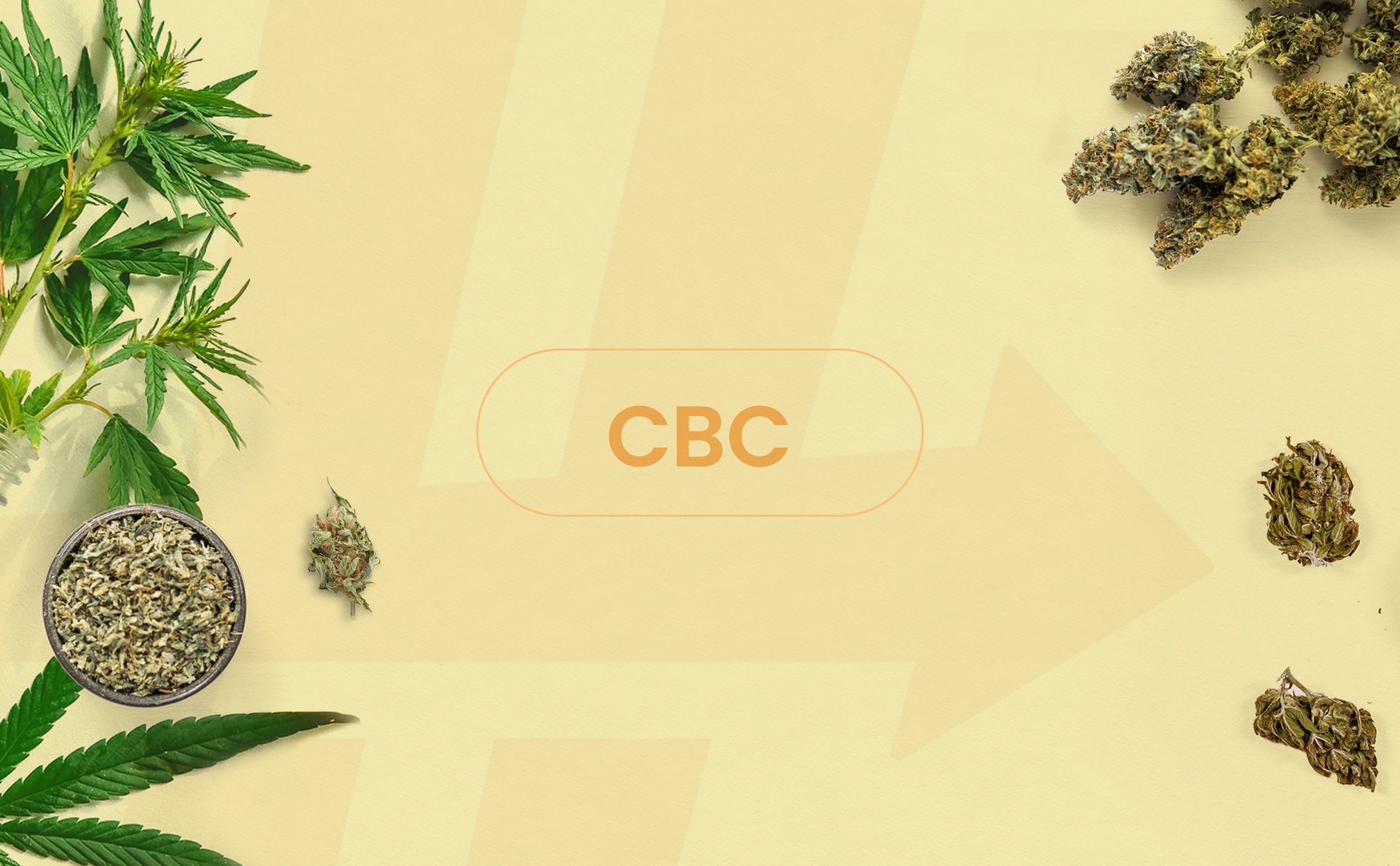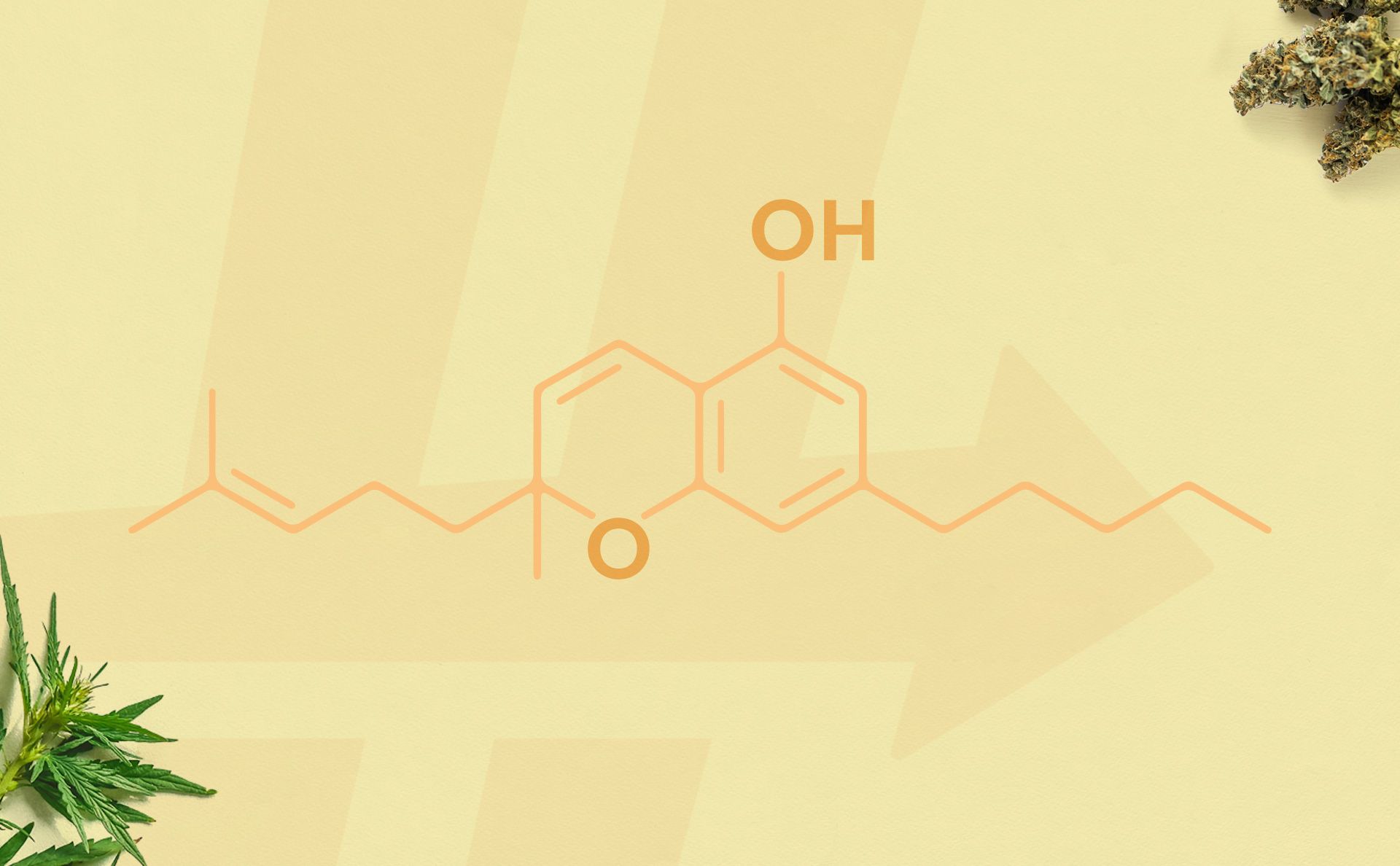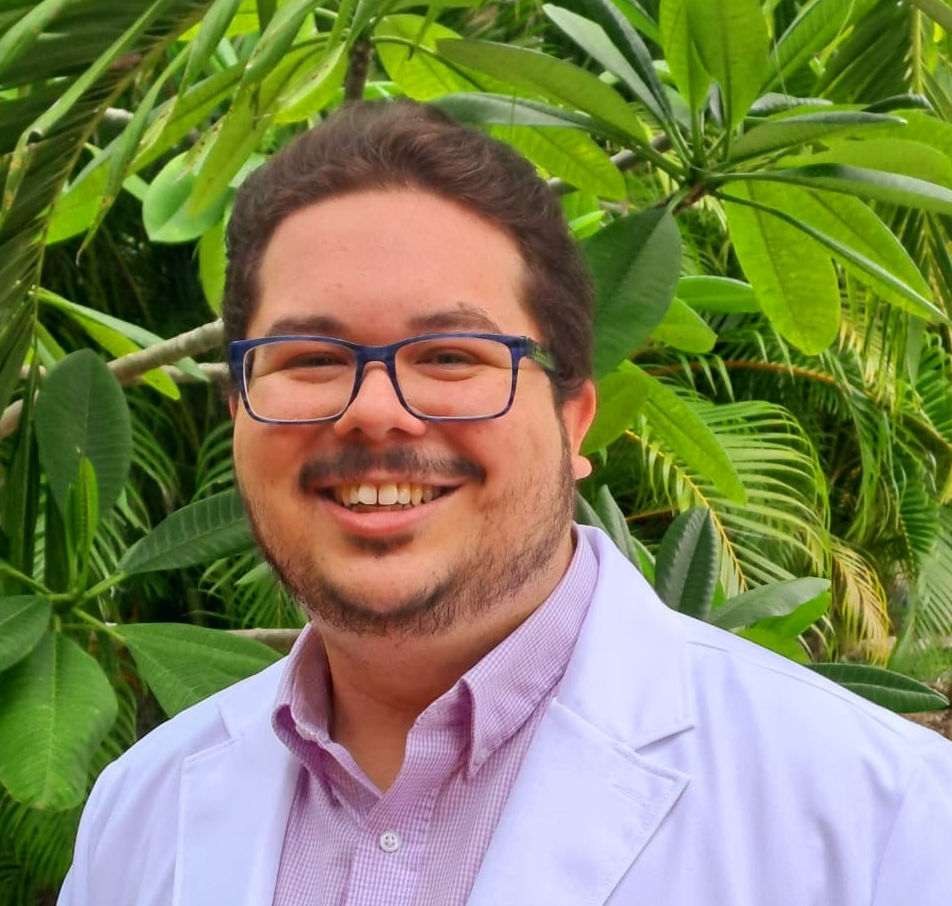CBC
What is CBC? What are the effects of this cannabinoid? And does this compound have any potential benefits? This chapter of our cannabinoids guide answers these questions.

What is CBC?
Cannabichromene, also known as CBC, is another example of a cannabinoid that is non-psychoactive. Even though it is considered one of the “big four” major cannabinoids, CBC is still one of the least clinically studied cannabinoids. Generally speaking, most cannabis experts refer to the 4 most common cannabinoid compounds: CBC, THC, CBD, and CBG as being major cannabinoids — the rest are minor.
Like all the other major cannabinoids, CBC originates from CBGA. Depending on which plant enzyme acts on it, CBGA can be converted into CBCA, and then into CBC after being exposed to sunlight and heat. This process is called decarboxylation, or colloquially abbreviated as “decarbing”. While the earliest cannabis leaves can be initially up to 90% CBC depending on cultivar and breeding technique, this greatly declines as it matures. Grown cannabis plants can only reach approximately 1-5% CBC.
Because less abundant cannabinoids like CBC must be isolated to test their own effects, there is little direct research, unlike THC and CBD. However, there are some promising initial tests on CBC that we will discuss later.
Currently, products from these cannabinoids are derived from legally grown hemp plants. As hemp was produced since the passing of the 2018 Farm Bill, the hemp industry has seen significant growth and expansion. Hemp suppliers extract minor cannabinoids and sell them in various products. These minor cannabinoid products include water-soluble extracts, isolates, distillates, and so on.

Hemp is now legal at the federal level in the U.S. As such, cannabinoids from hemp-derived products are becoming more widespread and commonly studied than THC-dominant cannabis. This should change in the future, as more legalization happens in states, and hopefully at the federal level.
Be advised there are now also psychoactive, semisynthetic hemp derivatives on the market like delta 8, HHC, THC-O, and more which vary in state legality and pose unique and unknown health risks. In the absence of regulations, hemp products largely remain “buyer beware”, except for those in licensed dispensaries.
Effects of CBC
Similar to CBD, CBC is non-psychoactive, meaning it doesn’t get you high like THC does. CBC and CBD do not interact with the CB1 receptors in the brain that make you feel like you’ve ingested THC.
With this in mind, there are some canna-curious consumers of products like CBD and CBC that may feel a profound sense of relaxation, rest, or pain relief that they’ve never felt before. This potential relief may lead to mood-boosting feelings similar to that of traditional cannabis, like happiness and being content, but without being intoxicated.
The possible side effects of cannabichromene aren't yet fully known, until it is studied more in humans. But so far, it appears they would be similar to that of CBD oil, since they often occur together anyway. Clinical data discussed below shows CBC is well-tolerated and generally as safe as the other major cannabinoids in a single clinical trial.

What the expert says...
Dr. Abraham Benavides
"Initial research tells us that the cannabinoid CBC has multiple potential benefits and properties. These include being a possible anti-inflammatory, tumor inhibitor, pain reliever, anti-seizure compound, and even a possible acne treatment, among others."
Potential Benefits of CBC
When it comes to clinical data, the evidence is limited as most of them are focused on pharmacokinetics (e.g. how fast the body absorbs CBC over THC, CBD). In this 2021 human pharmacology study, researchers found that daily doses of 26.4 mg of CBC are well-tolerated and appear safe in the presence of THC and CBD.
To date, there’s only one double-blind, clinical study done on CBC. Conducted in 2019, this multi-center, Canadian pediatric study demonstrates how a 1:20 THC:CBD oil containing 4% CBC is efficacious, therapeutic, safe, and well-tolerated in children with treatment-resistant epilepsy.
It is important to note that this study was conducted on cultivars high in CBD and CBC content, not cannabichromene itself. However, the authors suggest that the synergy, or entourage effect, between CBD, THC, and CBC could prove more efficacious than purified CBD alone for pediatric epilepsy.
Initial preclinical research indicates that CBC may have numerous potential benefits. Preliminary scientific studies indicate that CBC could have significant properties that may be:
- Anti-inflammatory
- Neuroprotective and neurodegenerative
- Anticancer
- Antiacne
- Antidepressant
- Anticonvulsant
- Antibiotic
- ARDS-protective
- Pain-relieving
- Gut motility-regulating
- Antifungal
Researchers who conducted studies on cannabichromene concluded that it inhibited the growth of tumor cells from lab rodents and human cell samples. Data suggest CBC may be of use as a tumor inhibitor, specifically for breast, prostate, gastric, colorectal, urothelial, or leukemia-type cancers. However, these studies have yet to be conducted in live patients.
Yet another study on CBC tells us that this versatile and potentially valuable cannabinoid acts upon the parts of the brain and nerves that register pain. CBC can block pain signals in lab mice with inflammatory pain. CBC may also help our immature (stem) nerve cells grow into healthy neurons, raising the possibility of neuroregeneration after brain or spinal cord injury. However, this requires much clinical study before it can be deemed a treatment.
CBC has also been studied in mice and shown to possibly help with their depression. Generally, antidepressant effects are common among cannabinoids, so we hope to see similar results replicated in humans someday with CBC.
Furthermore, the cannabinoid may even inhibit acne, which is a development that has led many in the CBD-focused skincare space to call for more tests on this compound.
We hope to see this need for studies and unbiased, benefit-focused, evidence-based research addressed as the layers of cannabis prohibition continue to be peeled back. Unbiased studies conducted on isolated compounds like CBC should be done in conjunction with the possibility of the entourage effect in mind, as seen in the 2019 pediatric study.
What We Learned: CBC
CBC is another major cannabinoid with unlocked potential. Here’s what we learned about this cannabinoid:
- Cannabichromene, also known as CBC, is another example of a cannabinoid that is non-psychoactive.
- CBC is one of the least studied major cannabinoids.
- Many cannabinoids are being studied more thanks to the 2018 Farm Bill which legalized hemp.
- Like other major cannabinoids, CBC originates from CBGA, then converts from CBCA into CBC after being exposed to light and heat.
- Like CBD, CBC is non-psychoactive, meaning it doesn’t get you high like THC does.
- Preliminary scientific studies indicate that CBC can have potent anti-inflammatory properties.
- CBC acts on nerves, neural stem cells, and parts of the brain that sense pain, indicating its possible effectiveness as a pain reliever, neuroprotective, and possibly even a neuroregenerative agent.
- The few clinical trials done on CBC show that CBC together with higher amounts of THC and CBD are likely safe, well-tolerated, and efficacious in humans and even children with treatment-resistant epilepsy.
The other major cannabinoids are found more abundantly in the cannabis plant, so compounds like CBC are some of the least commonly researched. It’s important to reiterate that few, if any, of these tests have reached their clinical stage, which is a crucial step for the advancement of cannabis research. So far, unlike CBD, CBC is not an FDA-approved treatment for any condition yet.
Ready to learn more about cannabinoids? Let’s keep moving and complete this guide.
Citations
- Aliferis, K. A., & Bernard-Perron, D. (2020). Cannabinomics: Application of Metabolomics in Cannabis (Cannabis sativa L.) Research and Development. Frontiers in Plant Science, 11, 554.https://doi.org/10.3389/fpls.2020.00554
- Cannabichromene (CBC) Cannabinoid Research. (2022). Cannakeys.https://cannakeys.com/cannabichromene-cbc-cannabinoid-research/
- El-Alfy, A. T., Ivey, K., Robinson, K., Ahmed, S., Radwan, M., Slade, D., Khan, I., ElSohly, M., & Ross, S. (2010). Antidepressant-like effect of Δ9-tetrahydrocannabinol and other cannabinoids isolated from Cannabis sativa L. Pharmacology, Biochemistry, ahttps://doi.org/10.1016/j.pbb.2010.03.004
- Huntsman, R. J., Tang-Wai, R., Alcorn, J., Vuong, S., Acton, B., Corley, S., Laprairie, R., Lyon, A. W., Meier, S., Mousseau, D. D., Newmeyer, D., Prosser-Loose, E., Seifert, B., Tellez-Zenteno, J., Huh, L., Leung, E., & Major, P. (2019). Dosage Related Ehttps://www.frontiersin.org/articles/10.3389/fneur.2019.00716
- Khodadadi, H., Salles, É. L., Shin, E., Jarrahi, A., Costigliola, V., Kumar, P., Yu, J. C., Morgan, J. C., Hess, D. C., Vaibhav, K., Dhandapani, K. M., & Baban, B. (2021). A potential role for cannabichromene in modulating TRP channels during acute respirhttps://doi.org/10.1186/s42238-021-00101-0
- Klahn, P. (2020). Cannabinoids-Promising Antimicrobial Drugs or Intoxicants with Benefits? Antibiotics, 9(6), 297.https://doi.org/10.3390/antibiotics9060297
- Maioli, C., Mattoteia, D., Amin, H. I. M., Minassi, A., & Caprioglio, D. (2022). Cannabinol: History, Syntheses, and Biological Profile of the Greatest “Minor” Cannabinoid. Plants, 11(21), 2896.https://doi.org/10.3390/plants11212896
- Oláh, A., Markovics, A., Szabó-Papp, J., Szabó, P. T., Stott, C., Zouboulis, C. C., & Bíró, T. (2016). Differential effectiveness of selected non-psychotropic phytocannabinoids on human sebocyte functions implicates their introduction in dry/seborrhoeic shttps://doi.org/10.1111/exd.13042
- Peters, E. N., MacNair, L., Mosesova, I., Christians, U., Sempio, C., Klawitter, J., Land, M. H., Ware, M. A., Turcotte, C., & Bonn-Miller, M. O. (2022). Pharmacokinetics of cannabichromene in a medical cannabis product also containing cannabidiol and Δ9-https://doi.org/10.1007/s00228-021-03232-8
- Peters, E. N., MacNair, L., Mosesova, I., Christians, U., Sempio, C., Klawitter, J., Land, M. H., Ware, M. A., Turcotte, C., & Bonn-Miller, M. O. (2022). Pharmacokinetics of cannabichromene in a medical cannabis product also containing cannabidiol and Δ9-https://doi.org/10.1007/s00228-021-03232-8
- Stone, N. L., Murphy, A. J., England, T. J., & O’Sullivan, S. E. (2020). A systematic review of minor phytocannabinoids with promising neuroprotective potential. British Journal of Pharmacology, 177(19), 4330–4352.https://doi.org/10.1111/bph.15185
- Valeri, A., Chiricosta, L., D’Angiolini, S., Pollastro, F., Salamone, S., & Mazzon, E. (2023). Cannabichromene Induces Neuronal Differentiation in NSC-34 Cells: Insights from Transcriptomic Analysis. Life, 13(3), 742.https://doi.org/10.3390/life13030742
- Walsh, K. B., McKinney, A. E., & Holmes, A. E. (2021). Minor Cannabinoids: Biosynthesis, Molecular Pharmacology and Potential Therapeutic Uses. Frontiers in Pharmacology, 12, 777804.https://doi.org/10.3389/fphar.2021.777804
- Zagožen, M., Čerenak, A., & Kreft, S. (2021). Cannabigerol and cannabichromene in Cannabis Sativa L. Acta Pharmaceutica, 71(3), 355–364.https://doi.org/10.2478/acph-2021-0021
Test your knowledge, track your progress and earn your badge.
CBC originates from CBGA, then converts from CBCA into CBC after being exposed to which elements?

Dr. Abraham Benavides
Dr. Abraham Benavides is an internationally-recognized cannabis research expert, experienced medical advisor, and full-tuition merit scholar of the George Washington University School of Medicine and Health Sciences. Dr. Abe enjoys helping patients as a writer, educator, and cannabis health coach at the GW Center for Integrative Medicine.